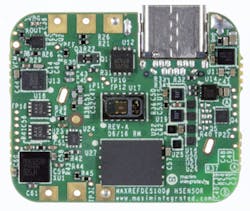Growing interest in wearable health and fitness monitoring devices and clothing is creating a difficult-to-meet demand for manufacturers. Fortunately, the MAXREFDES100# reference design from Maxim Integrated helps shave a good part of the development time by integrating several sensors on a tested and working printed-circuit board (PCB). The reference design is a good fit for health and medical devices equipped with Internet of Things (IoT) capabilities for ease of transferring data.
The modular reference design (see figure) includes a model MAX30003 biopotential analog front-end integrated circuit (IC), a model MAX30101 pulse oximeter and heart-rate sensor, two MAX30205 human-body temperature sensors, a three-axis accelerometer, a three-dimensional (3D) accelerometer and gyroscope, and an absolute barometric pressure sensor. The integrated solution measures just 25 × 30 mm; is optimized for low power consumption; and is supplied with software drivers, a debugging PCB, and a graphical user interface (GUI) to help speed the final-product design process. The design kit even includes standard and micro Universal Serial Bus (USB) cables for connecting the reference design board to a PC for programming.


